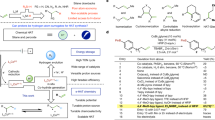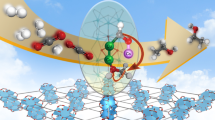Abstract
The reduction of CO2 into formic acid or its conjugate base, using dihydrogen, is an attractive process. While catalysts based on noble metals have shown high turnover numbers, the use of abundant first-row metals is underdeveloped. The key steps of the reaction are CO2 insertion into a metal hydride and regeneration of the metal hydride with H2, along with the concomitant production of formate. For the first step, copper is known as one of the most efficient metals, as shown by the numerous copper-catalysed carboxylation reactions, but this metal has difficulties activating H2 to achieve the second step. Here, we report a catalytic system involving a stable copper hydride that activates CO2, working in tandem with a Lewis pair that heterolytically splits H2. In this system, unprecedented turnover numbers for copper are obtained. Surprisingly, through a combination of stoichiometric and catalytic reactions, we show that classical Lewis pairs outperform frustrated Lewis pairs in this process.
This is a preview of subscription content, access via your institution
Access options
Access Nature and 54 other Nature Portfolio journals
Get Nature+, our best-value online-access subscription
$29.99 / 30 days
cancel any time
Subscribe to this journal
Receive 12 digital issues and online access to articles
$119.00 per year
only $9.92 per issue
Buy this article
- Purchase on Springer Link
- Instant access to full article PDF
Prices may be subject to local taxes which are calculated during checkout




Similar content being viewed by others
Data availability
CCDC 1839096 (B1), 1839093 (\({\mathbf{C}}_{\mathbf{1}}^{{\rm{C}}_{6}{\rm{F}}_{5}}\)), 1839094 (C3H) and 1839095 (3) contain the supplementary crystallographic data for this paper. These data can be obtained free of charge from the Cambridge Crystallographic Data Centre. All other data are available from the authors upon reasonable request.
References
Wang, W., Himeda, Y., Muckerman, J. T., Manbeck, G. F. & Fujita, E. CO2 hydrogenation to formate and methanol as an alternative to photo- and electrochemical CO2 reduction. Chem. Rev. 115, 12936–12973 (2015).
Alvarez, A. et al. Challenges in the greener production of formates/formic acid, methanol, and DME by heterogeneously catalyzed CO2 hydrogenation processes. Chem. Rev. 117, 9804–9838 (2017).
Sordakis, K. et al. Homogeneous catalysis for sustainable hydrogen storage in formic acid and alcohols. Chem. Rev. 118, 372–433 (2018).
Bontemps, S. Boron-mediated activation of carbon dioxide. Coord. Chem. Rev. 308, 117–130 (2016).
Fernandez-Alvarez, F. J., Aitani, A. M. & Oro, L. A. Homogeneous catalytic reduction of CO2 with hydrosilanes. Catal. Sci. Technol. 4, 611–624 (2014).
Inoue, Y., Izumida, H. & Hashimoto, H. Catalytic fixation of carbon dioxide to formic acid by transition metal complexes under mild conditions. Chem. Lett. 5, 863–864 (1976).
Dong, K., Razzaq, R., Hu, Y. & Ding, K. Homogeneous reduction of carbon dioxide with hydrogen. Top. Curr. Chem. 375, 1–26 (2017).
Tanaka, R., Yamashita, M. & Nozaki, K. Catalytic hydrogenation of carbon dioxide using Ir(iii)–pincer complexes. J. Am. Chem. Soc. 131, 14168–14169 (2009).
Bertini, F. et al. Carbon dioxide hydrogenation catalysed by well-defined Mn(i) PNP pincer hydride complexes. Chem. Sci. 8, 5024–5029 (2017).
Langer, R. et al. Low-pressure hydrogenation of carbon dioxide catalyzed by an iron pincer complex exhibiting noble metal activity. Angew. Chem. Int. Ed. 50, 9948–9952 (2011).
Zhang, Y. et al. Iron catalyzed CO2 hydrogenation to formate enhanced by Lewis acid co-catalysts. Chem. Sci. 6, 4291–4299 (2015).
Jeletic, M. S., Mock, M. T., Appel, A. M. & Linehan, J. C. A cobalt-based catalyst for the hydrogenation of CO2 under ambient conditions. J. Am. Chem. Soc. 135, 11533–11536 (2013).
Vogt, C. et al. Unraveling structure sensitivity in CO2 hydrogenation over nickel. Nat. Catal. 1, 127–134 (2018).
Watari, R., Kayaki, Y., Hirano, S.-I., Matsumoto, N. & Ikariya, T. Hydrogenation of carbon dioxide to formate catalyzed by a copper/1,8-diazabicyclo[5.4.0]undec-7-ene system. Adv. Synth. Catal. 357, 1369–1373 (2015).
Zall, C. M., Linehan, J. C. & Appel, A. M. A molecular copper catalyst for hydrogenation of CO2 to formate. ACS Catal. 5, 5301–5305 (2015).
Zall, C. M., Linehan, J. C. & Appel, A. M. Triphosphine-ligated copper hydrides for CO2 hydrogenation: structure, reactivity, and thermodynamic studies. J. Am. Chem. Soc. 138, 9968–9977 (2016).
Wang, S., Du, G. & Xi, C. Copper-catalyzed carboxylation reactions using carbon dioxide. Org. Biomol. Chem. 14, 3666–3676 (2016).
Liu, Q., Wu, L., Jackstell, R. & Beller, M. Using carbon dioxide as a building block in organic synthesis. Nat. Comm. 6, 5933 (2015).
Welch, G. C., Juan, R. R. S., Masuda, J. D. & Stephan, D. W. Reversible metal-free activation. Science 314, 1124–1126 (2006).
Stephan, D. W. The broadening reach of frustrated Lewis pair chemistry. Science 354, aaf7229 (2016).
Stephan, D. W. & Erker, G. Frustrated Lewis pairs: metal-free hydrogen activation and more. Angew. Chem. Int. Ed. 49, 46–76 (2010).
Courtemanche, M. A. et al. Intramolecular B/N frustrated Lewis pairs and the hydrogenation of carbon dioxide. Chem. Commun. 51, 9797–9800 (2015).
Ashley, A. E., Thompson, A. L. & O’Hare, D. Non-metal-mediated homogeneous hydrogenation of CO2 to methanol. Angew. Chem. Int. Ed. 48, 9839–9843 (2009).
Voss, T. et al. Frustrated Lewis pair behavior of intermolecular amine/B(C6F5)3 pairs. Organometallics 31, 2367–2378 (2012).
Liu, L., Vankova, N. & Heine, T. A kinetic study on the reduction of CO2 by frustrated Lewis pairs: from understanding to rational design. Phys. Chem. Chem. Phys. 18, 3567–3574 (2016).
Melaimi, M., Jazzar, R., Soleilhavoup, M. & Bertrand, G. Cyclic (alkyl)(amino)carbenes (CAACs): recent developments. Angew. Chem. Int. Ed. 56, 10046–10068 (2017).
Wyss, C. M., Tate, B. K., Bacsa, J., Gray, T. G. & Sadighi, J. P. Bonding and reactivity of a μ-hydrido dicopper cation. Angew. Chem. Int. Ed. 52, 12920–12923 (2013).
Jordan, A. J., Lalic, G. & Sadighi, J. P. Coinage metal hydrides: synthesis, characterization, and reactivity. Chem. Rev. 116, 8318–8372 (2016).
Jordan, A. J., Wyss, C. M., Bacsa, J. & Sadighi, J. P. Synthesis and reactivity of new copper(i) hydride dimers. Organometallics 35, 613–616 (2016).
Frey, G. D., Donnadieu, B., Soleilhavoup, M. & Bertrand, G. Synthesis of a room-temperature-stable dimeric copper(i) hydride. Chem. Asian J. 6, 402–405 (2011).
Romero, E. A. et al. Spectroscopic evidence for a monomeric copper(i) hydride, and crystallographic characterization of a monomeric silver(i) hydride. Angew. Chem. Int. Ed. 56, 4024–4027 (2017).
Hu, X. B., Soleilhavoup, M., Melaimi, M., Chu, J. X. & Bertrand, G. Air-stable (CAAC)CuCl and (CAAC)CuBH4 complexes as catalysts for hydrolytic dehydrogenation of BH3NH3. Angew. Chem. Int. Ed. 54, 6008–6011 (2015).
Collins, L. R., Rajabi, N. A., Macgregor, S. A., Mahon, M. F. & Whittlesey, M. K. Experimental and computational studies of the copper borate complexes [(NHC)Cu(HBEt3)] and [(NHC)Cu(HB(C6F5)3]. Angew. Chem. Int. Ed. 55, 15539–15543 (2016).
Maity, A. & Teets, T. S. Main group Lewis acid-mediated transformations of transition-metal hydride complexes. Chem. Rev. 116, 8873–8911 (2016).
Jiang, C., Blacque, O., Fox, T. & Berke, H. Heterolytic cleavage of H2 by frustrated B/N Lewis pairs. Organometallics 30, 2117–2124 (2011).
Mahoney, J. K., Martin, D., Moore, C. E., Rheingold, A. L. & Bertrand, G. Bottleable (amino)(carboxy) radicals derived from cyclic (alkyl)(amino)carbenes. J. Am. Chem. Soc. 135, 18766–18769 (2013).
Lavallo, V., Canac, Y., Prasang, C., Donnadieu, B. & Bertrand, G. Stable cyclic (alkyl)(amino)carbenes as rigid or flexible, bulky, electron-rich ligands for transition metal catalysts: a quaternary carbon makes the difference! Angew. Chem. Int. Ed. 44, 5705–5709 (2005).
Tomás-Mendivil, E. et al. Bicyclic (alkyl)(amino)carbenes (BICAACs): stable carbenes more ambiphilic than CAACs. J. Am. Chem. Soc. 139, 7753–7756 (2017).
Geier, S. J., Gille, A. L., Gilbert, T. M. & Stephan, D. W. From classical adducts to frustrated Lewis pairs: steric effects in the interactions of pyridines and B(C6F5)3. Inorg. Chem. 48, 10466–10474 (2009).
Johnstone, T. C., Wee, G. N. J. H. & Stephan, D. W. Accessing frustrated Lewis pair chemistry from a spectroscopically stable and classical Lewis acid‐base adduct. Angew. Chem. Int. Ed. 57, 5881–5884 (2018).
Mömming, C. et al. Reversible metal-free carbon dioxide binding by frustrated Lewis pairs. Angew. Chem. Int. Ed. 48, 6643–6646 (2009).
Weinberger, D. S. et al. Isolation of neutral mononuclear copper complexes stabilized by two cyclic (alkyl)(amino)carbenes. J. Am. Chem. Soc. 136, 6235–6238 (2014).
Santoro, O. et al. A general synthetic route to [Cu(X)(NHC)] (NHC = N-heterocyclic carbene, X = Cl, Br, I) complexes. Chem. Commun. 49, 10483–10485 (2013).
Jin, L., Romero, E. A., Melaimi, M. & Bertrand, G. The Janus face of the X ligand in the copper-catalyzed azide–alkyne cycloaddition. J. Am. Chem. Soc. 137, 15696–15698 (2015).
Jazzar, R. et al. Intramolecular “hydroiminiumation” of alkenes: application to the synthesis of conjugate acids of cyclic alkyl amino carbenes (CAACs). Angew. Chem. Int. Ed. Engl. 46, 2899–2902 (2007).
Berthon-Gelloz, G. et al. IPr* an easily accessible highly hindered N-heterocyclic carbene. Dalton Trans. 39, 1444–1446 (2010).
Weber, S. G., Loos, C., Rominger, F. & Straub, B. F. Synthesis of an extremely sterically shielding N-heterocyclic carbene ligand. Arkivok iii, 226–242 (2012).
Acknowledgements
This work was supported by the US Department of Energy, Office of Science, Basic Energy Sciences, Catalysis Science Program, under award number DE-SC0009376, Solvay and the NNSF of China (numbers 21676134 and 21576129). We gratefully acknowledge support from the US Department of Education for a GAANN fellowship (E.A.R.) and the Japan Society for the Promotion of Science for a Postdoctoral Fellowship for Study Abroad (R.N.).
Author information
Authors and Affiliations
Contributions
E.A.R., R.N. and R.J. performed the stoichiometric experiments, mechanistic studies and X-ray crystallographic analyses. R.J. and G.B. developed the synergistic mechanism. T.Z. and X.H. performed the catalytic studies. X.H. and Y.W. developed the catalytic conditions for the reduction of CO2 using CAACCuBH4. All authors discussed the results and wrote the paper.
Corresponding authors
Ethics declarations
Competing interests
The authors declare no competing interests.
Additional information
Publisher’s note: Springer Nature remains neutral with regard to jurisdictional claims in published maps and institutional affiliations.
Supplementary Information
Supplementary Information
Supplementary Methods, Supplementary Figures 1–13, Supplementary Tables 1–4, Supplementary References
Compound 3
Crystallographic data for compound 3
Compound B1
Crystallographic data for compound B1
Compound C1C6F5
Crystallographic data for compound C1C6F5
Compound C3H
Crystallographic data for compound C3H
Rights and permissions
About this article
Cite this article
Romero, E.A., Zhao, T., Nakano, R. et al. Tandem copper hydride–Lewis pair catalysed reduction of carbon dioxide into formate with dihydrogen. Nat Catal 1, 743–747 (2018). https://doi.org/10.1038/s41929-018-0140-3
Received:
Accepted:
Published:
Issue Date:
DOI: https://doi.org/10.1038/s41929-018-0140-3
This article is cited by
-
Harmonious hydrogenation catalysts
Nature Catalysis (2018)



